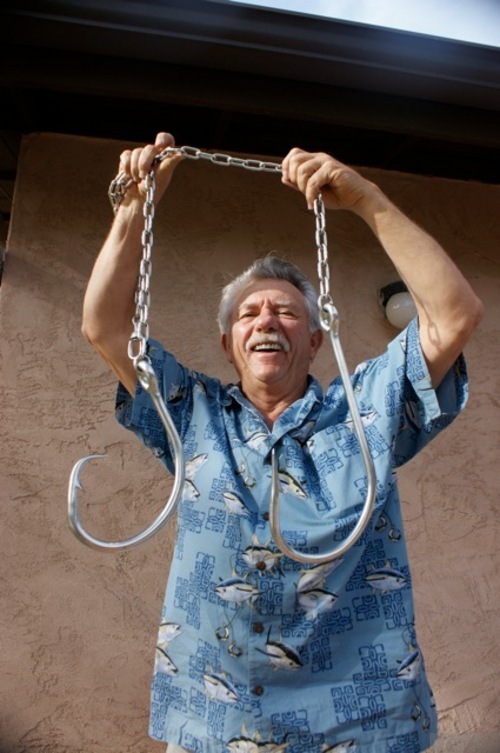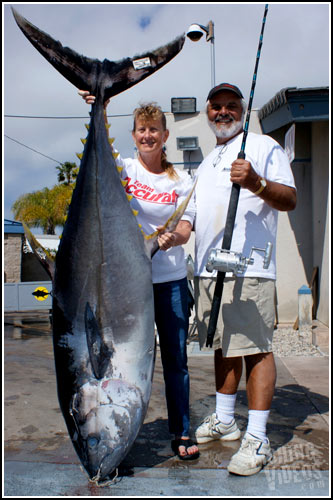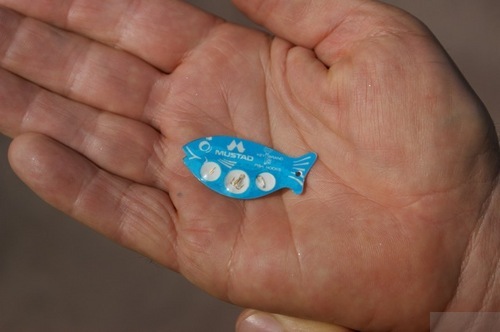Long Range Fish Report
From Sportfishing
From Sportfishing
Fish Report for 3-2-2010

Now That’s A Hook!
3-2-2010
Bill Roecker
Hooks are the primary connection to fish for anglers. So it should be no surprise that there's a lot of competition for hook sales among manufacturers. Before I discuss the latest from Mustad, let me say that I also use and can recommend other brands as well, like Owner, Eagle Claw, Hayabusa, VMC, etc.
I caught my first fish when I was four, in 1946, under grandpa's supervision. It was a Wisconsin bluegill, and it took a red wiggler on a Mustad hook, fished with a cane pole, some green braided line and a bobber in Plainfield Lake. At the ripe age of nine, I caught sticklebacks in my neighborhood creek in Eugene, Oregon on a piece of red wiggler worm on a tiny Mustad about size 20, and learned about their behavior in my aquarium.
The company is the world's oldest and largest, I believe. On sport boats, I've heard the name pronounced as Mustang and Mustard, among others. But the original name is O. Mustad & Son. The company began making steel wire and nails, and started making hooks in 1877. In March 2010 Mustad is represented at the Fred Hall show in Long Beach by Steve Tanaka, an able fisherman himself, and the man who provided the hooks pictured here.
Readers and viewers are already aware of the extremely large white sharks caught recently for tagging and release at Guadalupe Island. Special hooks for the task were made by Mustad, in 5X strength. The hooks shown are a 19/0 J hook model 4483DT and a 27/0 circle hook. Chain link was used instead of leader, and the circle hook was baited with a trio of skipjack. Now that's a hook!
Even long rangers and blue marlin fishermen can't use hooks that large. They might like something like the new Mustad 5x strength 16/0 and 14/0 circle hooks shown here. Over the past couple of years long range boats like Royal Polaris, Excel and others have made good use of 20/0 circle hooks to dangle kite baits for cows, tuna over 200 pounds.
Tuna and yellowtail are favorite local and long range species, and while I prefer ringed circle hooks like the new Mustad models shown, J hooks are cheaper and still preferred by many anglers.
I think J hooks are better with rings, too, but when school fish are frenzied and you're losing a lot of terminal tackle, cheaper might make more sense, and a ring probably doesn't make much difference in drawing strikes. When fish are finicky, I'm plugging rings. There is some general agreement among anglers that circles are better for releasing fish with minimal damage.
Tiny hooks for trout and other finicky or small-jawed species have been a specialty of the company for longer than I've been around, and I grew up fishing stream rainbows with my buddies, using four-pound line and two-pound leader. We used a lot of gold "salmon egg" hooks sized 10 to 14. Later I learned to fish dry flies and wet flies sized as small as 20.
The hooks in the little Mustad package shown here go down to size 32, Tagami told me, and the 32 is used mostly by rod wrappers instead of fish catchers.
That's the large and the small of it right now. If you'd like to talk hooks, stop by the various booths up at the Fred Hall Show, where reps will be pleased to offer information. Steve Tagami will be at the Mustad display until next Sunday.
If you'd like to dig a bit deeper, a good book to look for is "A History of the Fish Hook," by Hans Jorgen Hurum. It was commissioned by Mustad, I believe, and printed by The Pittman Press of Bath, in Great Britain, in 1977. The book traces the history of the fish hook from the Stone Age to the present, and offers many photos and insightful knowledge.
I caught my first fish when I was four, in 1946, under grandpa's supervision. It was a Wisconsin bluegill, and it took a red wiggler on a Mustad hook, fished with a cane pole, some green braided line and a bobber in Plainfield Lake. At the ripe age of nine, I caught sticklebacks in my neighborhood creek in Eugene, Oregon on a piece of red wiggler worm on a tiny Mustad about size 20, and learned about their behavior in my aquarium.
The company is the world's oldest and largest, I believe. On sport boats, I've heard the name pronounced as Mustang and Mustard, among others. But the original name is O. Mustad & Son. The company began making steel wire and nails, and started making hooks in 1877. In March 2010 Mustad is represented at the Fred Hall show in Long Beach by Steve Tanaka, an able fisherman himself, and the man who provided the hooks pictured here.
Readers and viewers are already aware of the extremely large white sharks caught recently for tagging and release at Guadalupe Island. Special hooks for the task were made by Mustad, in 5X strength. The hooks shown are a 19/0 J hook model 4483DT and a 27/0 circle hook. Chain link was used instead of leader, and the circle hook was baited with a trio of skipjack. Now that's a hook!
Even long rangers and blue marlin fishermen can't use hooks that large. They might like something like the new Mustad 5x strength 16/0 and 14/0 circle hooks shown here. Over the past couple of years long range boats like Royal Polaris, Excel and others have made good use of 20/0 circle hooks to dangle kite baits for cows, tuna over 200 pounds.
Tuna and yellowtail are favorite local and long range species, and while I prefer ringed circle hooks like the new Mustad models shown, J hooks are cheaper and still preferred by many anglers.
I think J hooks are better with rings, too, but when school fish are frenzied and you're losing a lot of terminal tackle, cheaper might make more sense, and a ring probably doesn't make much difference in drawing strikes. When fish are finicky, I'm plugging rings. There is some general agreement among anglers that circles are better for releasing fish with minimal damage.
Tiny hooks for trout and other finicky or small-jawed species have been a specialty of the company for longer than I've been around, and I grew up fishing stream rainbows with my buddies, using four-pound line and two-pound leader. We used a lot of gold "salmon egg" hooks sized 10 to 14. Later I learned to fish dry flies and wet flies sized as small as 20.
The hooks in the little Mustad package shown here go down to size 32, Tagami told me, and the 32 is used mostly by rod wrappers instead of fish catchers.
That's the large and the small of it right now. If you'd like to talk hooks, stop by the various booths up at the Fred Hall Show, where reps will be pleased to offer information. Steve Tagami will be at the Mustad display until next Sunday.
If you'd like to dig a bit deeper, a good book to look for is "A History of the Fish Hook," by Hans Jorgen Hurum. It was commissioned by Mustad, I believe, and printed by The Pittman Press of Bath, in Great Britain, in 1977. The book traces the history of the fish hook from the Stone Age to the present, and offers many photos and insightful knowledge.
Photos
< Previous Report Next Report >
More Reports
Fishing Videos Reports
for Tuesday, March 2nd, 2010
• Giant Yellowfin Tuna: The Cow Count
• Izorline Trip Back With A Blue Moon Story
• It’s Showtime! Bring The Kids

2-27-2010
ACCURATE 18-DAY RETURNS!!! Frank LoPreste's Royal Polaris returned to Fisherman's Landing February 25 after the annual 18-day Accurate trip. Chartermaster...... Read More

LongRangeSportfishing.net © 2025. All Rights Reserved.
Website Hosting and Design provided by TECK.net
Website Hosting and Design provided by TECK.net

